Iron shirt
An “iron shirt” appeared in ancient times, although it is impossible to say exactly where and when. This event is on a par with the invention of the wheel, the knife, the domestication of animals: these momentous steps were taken at about the same time in different places. It is known that already in the middle of I millennium BC. er ringed armor was used in Asia, reached the Sarmatians of the northern Black Sea region, and this is Russian land. Scythians also lived here, and chain armors dating back to the 5th century BC are also found in their graves. er
The Roman Empire first encountered the “iron shirt”, fighting in the East against Asians and in the West against the Celts (now the territory of France and England), who had known this protective clothing since the 4th century BC. er But there is nothing surprising: this mysterious people came to Europe from the East. In addition, even more mysterious Etruscans lived before the Romans on the Apennine Peninsula, and their found armor dates back to the 3rd century BC. er So the "teachers of Europe" Romans had someone to learn, and they successfully mastered this technology. Their ringed armor has become “Lorika Hamat”. It was made of bronze or iron. One shirt would take up 40 000 rings, giving flexible and durable protection. There were several versions of this armor for various types of troops - shooters, spearmen, cavalry. Then it was replaced by a lamellar "lorica segmentation", but under the decline of the empire, Lorica hamata again became the standard armor of Roman legionnaires. Rome fell, and comfortable and reliable chain mail continued to live in the world, existing in many varieties.
This is how the Greek historian Leo-Deacon of Koloy described our distant ancestors who fought with the Byzantine army near the city of Dorostol on the Danube in 971: “Scythians left the city on the field with long, to the very feet, shields, in chain mail armor”; "The chain armor and shield that Svetoslav armed himself with, he was protected from Roman swords." The Byzantines (“Romans”) were called the “Scythians” of the ancient Russian soldiers of Prince Svyatoslav.
Production
In Russia, the “iron shirt” was made by a specialist in chain mail. Being a complex and time-consuming product of blacksmith art, it required a streamlined technology, a lot of time and physical effort. At first, “scrap iron” was produced from iron ore - a solid spongy mass. The ingot-crista was subjected to intensive processing, repeatedly forging in the heated state, removing slag from the metal. Ultimately, there remained a malleable iron, from which long thin rods were forged. On one chain mail went no less than 600 m wire thickness of approx. 2 mm. It was obtained by two methods. First: just forged the rod to the desired thickness, which lasted a very long time, and the wire was uneven. More productive was the method of drawing (and therefore "pro-portage"), which gave a better product. It consisted in pulling the rod through a series of successively decreasing cone-shaped holes in the iron plate. In the forge, two pillars were broken into the ground, a drawing board was fastened between them, and on the contrary a swing was hung from the ceiling. The blacksmith sat on them, grabbed a red-hot rod with his tongs, thrust into the first, largest hole, and, pushing his feet off the pillars, flew up, pulling a hot, supple, yet thick iron cord. At the top he let him go, flew down, intercepted the workpiece with pliers, pushed his legs and flew up again. And so many times, because in order to transform an initial bar 5 mm thick into a wire with a 2 mm section, it was necessary to stretch it through 30 gradually decreasing holes in the drawing board. From time to time more and more thinning wire was burned in the forge to eliminate the rigidity acquired during drawing. The finished wire was wound on an iron bar-mandrel with a thickness of just over 1 cm, forming a long helix, a blank for future rings. Combat practice has shown that for the flexibility of the armor, the inner diameter of the ring should be five times the diameter of the wire. When the diameter of the rings is too large, the protective properties of their plexus are sharply reduced, so that the average diameter of the rings of medieval chain mail rarely exceeded 10 mm.
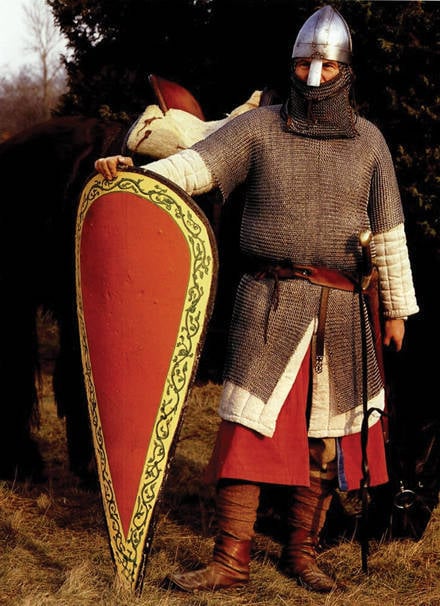
Then the helix was cut on one side, getting open rings. Having forged them in a special stamp, some of them were tightly welded by forge welding, while the others were tweaking the ends and piercing holes for rivets there, which, in turn, were specially made. Sometimes, to facilitate and speed up the process, the blacksmith cut with a special notch seamless rings made of iron sheet with a thickness of 1,5 – 2 mm. Thorough, monotonous work produced thousands of rings of different types. So they worked in Russia. In medieval Europe, the process was even more laborious. In the "dark ages" they lost the technology of wire drawing, and therefore each ring was forged separately.
After that, the "iron shirt" was collected, starting from the shoulders and ending with the hem. Each open ring connected with four welded and riveted. It was the easiest weaving option (4 to 1). Russian masters owned and more complex weaving (6 in 1, 8 in 1, 8 in 2). It improved the protective properties of the chain mail, it became thicker, but it increased its weight, production time and cost. In conclusion, separately manufactured sleeves and neck were woven into it. Rings were usually of the same diameter, only in the late Middle Ages began to combine different-sized rings, covering the most vulnerable parts of the body with small weaving. In addition, in particularly complex chain mails, the thickness of the wire was varied: the most massive rings went to the chest and back, medium ones went to the sides, and thin to the sleeves and shoulders. Of course, between them remained the lumen 4 – 6 mm, through which the enemy tip could penetrate to the body, and therefore before the battle they put on a second coat of armor who could afford it. And on the march armor, as well as heavy weapons, carried in a train.
Depending on the size of the armor, with 1 – 2 mm wire thickness and 10 mm ring diameter, one “iron shirt” took at least 15 000, more often 20 – 25 000, and by the end of the XIII century - up to 30 000 rings. Weight also varied, from 5 to 15 kg. After the assembly, the chain mail was cleaned and polished with sand to shine. Sometimes for elegance copper rings were woven into it. It could serve for centuries, because if it was damaged, it was enough to patch the holes in a handful of new rings. With the army drove the master, repaired chain mail right in the campaign. This is evidenced by sets of miniature tools found during excavations.
The earliest chain mails were made of converged rings, their ends were not held together; later - most often from welded-riveted. There were chain mail, where all the rings were riveted. In the production of ancient Russian chain mail, the diminutiveness and laboriousness of the blacksmith’s work are striking. So, riveting the ring with a rivet of diameter 0,75 mm was made with the ring not lying separately, but already woven into chain mail! And so - 10 000 times for one "iron shirt". Our ancestors were capable of such fine work. They were constantly improving the technology: in the “Pansyri” of the local cavalry of the Moscow State, the rings were no longer fastened with a separate rivet, but with a spike forged on the ring itself. The cut of chain mail also changed, she was also a swing, like a jacket. In this case, the right (outer) side trudged from massive rings, and the left (inner) side - from thinner ones. Overlapped floors created double protection from the most threatened frontal side. Combat stockings (“leggings”), “bracers”, mail gloves and “barmitsa” were made of iron rings — a chain mail net on a combat helmet to protect the warrior’s neck and shoulders.
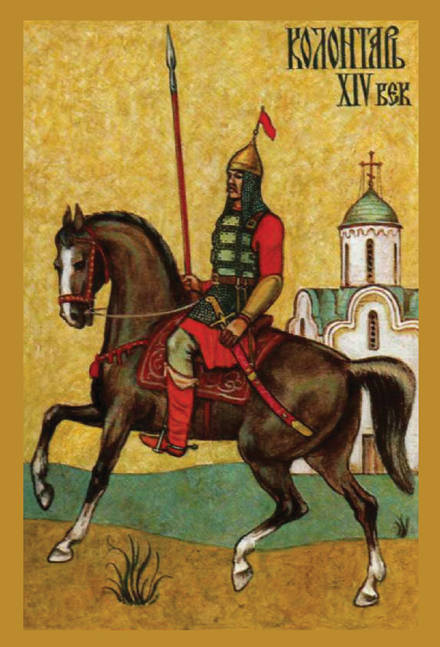
Previously it was thought that the production of an ordinary product required several months of work, however, calculations showed that the assembly / weaving of small chain mail from 20000 rings took only 200 man hours, that is, one workshop could supply them up to ten or more per month. In 1983, in the city of Elektrostal, in the course of studying the military production of Ancient Russia, an experiment was carried out with the exact observance of the technologies of that era - a full chain mail armor with stockings and mittens was made. Man-hours accounted for 250 man-hours. For comparison: the labor costs for the manufacture of one Volga GAZ-21 car in the middle of 60 were 154 man-hours.
"The Age of Mail"
500 years from the VIII to XIII century, historians call the "age of chain mail." It was the main defensive armor of the Russians, appearing among them much earlier than in Western Europe. So, in the territory of Ancient Russia, archaeologists found 112 "iron shirts", of which 40 are whole. Their European colleges cannot boast of such a number of such finds. Mail in Russia was accessible to all: professional squad members, militia, urban and rural residents. Moreover, it was also in the city’s arsenals, so that the city could arm the poor, who could not afford the equipment.
All this is evidence of the high level of state organization. Mass production of armor is an indicator of the military and general culture of the people, their activity and resilience. It happens only where there is a city, a class of artisans.
And the Scandinavians called Ancient Russia "Gardarika", the country of cities. Armor was made everywhere. Sovereigns and local rulers followed the armament of their troops and always wanted to have gunsmiths and bronnikov in their hands. Masters of specific types of weapons settled concentrated, their villages, areas. It sounds today, for example, in Moscow: the Blacksmith's Bridge, Malaya Bronnaya Street, Bronnitsy ... From the XII century in Russia there was a clear specialization in the manufacture of weapons, their unification and standardization. There was a mass production, the weapon and armor became mass. In the West, expensive armor and weapons were a sign of wealth, nobility, belonging to a feudal lord or a professional warrior. And in Russia, the sword and armor were an integral feature of a free man who has the natural (“from God”) right to possess any weapon. The hostile onslaught of the West and the East, the continuous wars forced the “civilian” Russians to arm themselves as well as the combatants.
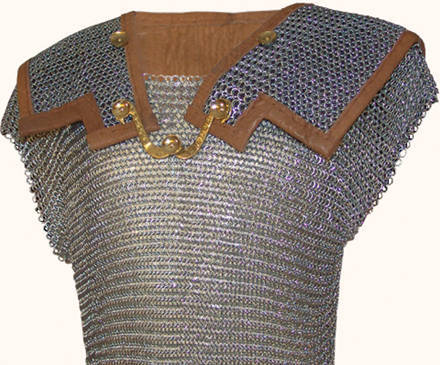
Hauberk - Baidana - Lats
In medieval Europe, there were different types of "iron shirt", and the Russian and Western European chain mail was very different from each other. A short shirt, covering only the torso and shoulders, was worn in Russia. She weighed an average of 7 kg, reached the middle of the thigh, the wide sleeves were a maximum to the elbow or were completely absent. It was buttoned without odor, the slit of the collar was in the middle of the neck or slightly to the side. During the excavation of the Raikovetsky settlement (XI – XII cc.) Two such armor was found: length 70 cm, width at the shoulders 100 / 130 cm, in the belt 60 / 66 cm, weight 6 kg, each of 35 000 (123 / 125 series ) rivet rings with a diameter of up to 11 mm. In Western Europe, such an “economy class” was worn by those who could not afford long armor, and also to enhance protection over long chain mail. They were dressed in “hauberk”, long chain mail weighing more than 10 kg, covering the body from neck to legs, with sleeves to the elbows, hem to the knees, with cuts on it in front and behind for landing on a horse. She was worn with chain stockings and wristbands. In Eastern Europe, the earliest fully preserved hauberks were found in the Black Tomb near Chernigov and dated 970 for the year.
From the XIII century long-sleeved sleeves extended to the brush, there was a chain mail hood. In the western hauberke the hood was one with it. They wore canvas robes with short sleeves over their armor to protect them from dust and overheating in the sun, in Asia with the same purpose - a robe. And the Russians liked to walk in open armor: “When the Russians came, they could see a lot of light armor, their helmets and swords shone; I believe that they went on a campaign in the Russian way, ”“ They shone like the sun, so beautiful in appearance was their weapon ”(Swedish“ Erik Chronicle ”, XIV century).
Then the ways of the Russians and Europeans in creating combat armor diverged even more. Since 1200, a new type of ringed armor has appeared in Russia - “Baidana bessermenskaya” (i.e., basurmanskaya, eastern). It was made from large flat rings. This type of armor expanded the iron field 1,5 – 2 times without increasing the weight of the armor, it did not exceed 6 kg. The main feature was the size and shape of the rings. These large flat-lined washers were made by stamping from a blank - a ring of thick wire. He was put in a stamp and pierced with a hammer, getting an open washer with overlapping ends, which were drilled and riveted when weaving, getting a joint of great strength. Baidana reliably defended saber strikes, but could not save from piercing weapons and arrows due to the large diameter of the rings, and therefore she wore auxiliary over the usual chain mail. The large size of the washers allowed to write on them by stamping or engraving. So, the baidan Boris Godunov with weight 6 kg has been preserved, on the rings of which “No one with us on God” is stamped on us. Russian baidana, as a rule, was buttoned on its side, east - in the middle, and sometimes it was completely worn over the head.
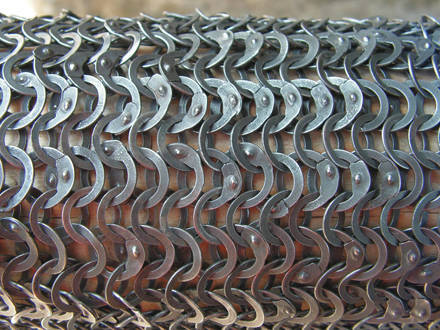
And in Europe they began to make solid forged (“white”) gothic armor. Sometimes it is claimed that this was “absolutely complete and invulnerable protection”, but this is not true. Russian and Eastern (Tatar, Janissary) onions completely punched this defense. And the glory of the English archers of the 14th century, who shot French knights from their long bows in the Hundred Years War, was also confirmed by medieval authors. But the enemy was different. The Europeans had the same chained knight or black people, inept and poorly armed. The Russian warrior was opposed by the mobile warlike steppe, which could only be beaten in a fast-paced battle that required high speed and mobility. And the short “iron shirt” was much more convenient here.
"Board armor"
But the strengthening of the armor went on in Russia. In the XV century there was a turn to the production of weapons on the eastern patterns. In the annals there were new words: “wrought men”, “board armor”. Excellent "board armor" began to make Novgorod, Pskov, Smolensk masters. It was a plate (lamellar) armor, made of narrow plates of iron, woven into chain mail, and combining its flexibility and strength of plate armor. Its varieties were Bekhterets and Yushman. Their names are converted Persian words “begter” and “djawshan”. They consisted of horizontal plates, overlapped in vertical rows. The difference was in the size of the parts. Bechterets were made from a large number (up to 1500 pieces) of small elongated plates of length 8 – 10 cm, width 2 – 4 cm, connected by rings on short sides. Their large overlap (on 2 / 3) created a double and triple coating, and each row overlapped the next, giving elastic and durable protection against sabers and arrows. And this is with a separate plate thickness of only 1 mm, which is easily bent by hand. Is that impossible? It is even possible. As in a broom, the bars of which are easy to break individually, but not all together ...
The 1465 miniature of the year in Baghdad shows Asian Bechterets: it has sleeves, a long mail hem and fasteners in the middle; at times he was completely worn over his head. But the Russian Bekhterets was a sleeveless vest and hem worn over the chain mail, and was fastened with a metal buckle on the shoulder and side, its weight reached 12 kg.
The less elastic Yushman had up to hundreds of much larger plates embedded in a ring covering in horizontal rows with a slight overlap of each other. Sometimes they were gilded or silver, and such armor was very expensive. Yushman had a full incision from neck to hem, put on sleeves like a caftan, fastened on loops, could be worn over the chain mail and weighed up to 15 kg. The first report about him refers to the 1548 year: “Start by arming yourself, put yourself on Yushman” (Nikon chronicle).
A rarer type of ring-plate armor was Calantar. It was made of relatively large square plates fastened with chain mail weaving and located without overlapping. The armor was sleeveless and consisted of the front and back half, which were fastened on the shoulders and sides with iron buckles. The chain net (hem) to the knees was attached to the belt. To improve mobility, the dorsal plates were thinner and smaller than the pectoral plates. Calantar as a ceremonial armor for a noble person, decorated with a gold notch, engraved, slash ornament, cost up to 1000 rubles, which was at that time an astronomical sum.
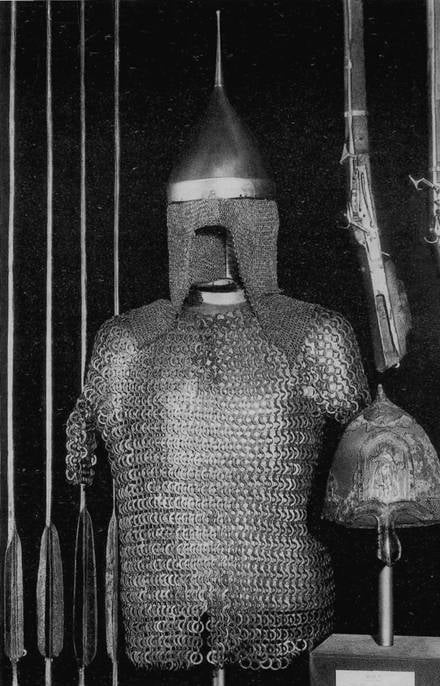
There was also a scaly armor, where the plates were sewn on leather or cloth basis. His Russia borrowed from the Byzantines. Plates of such armor, square / rectangular in shape, 6 x 4, 6 x 6 cm in size and the number of 200 – 600 pieces, like tiles or scales, overlapped the bottom row. The side plates of each row overlapped one another, and in the middle were still riveted to the base. The length of the "scales" was up to the hips, the hem and sleeves were made of longer plates. Compared with the “board armor” it was much more elastic.
Protective properties
Despite the wide distribution, the “iron shirt” did not give complete protection, and what kind of armor can give it? The rings were made of soft iron (hard steel would break upon impact), and such armor was cut with a saber, pierced with a spear and cut with a sword, poorly protected from arrows: they penetrated the mesh, special faceted tips were especially dangerous. Therefore, often in addition to the chain mail, “scales” were worn, Baidan, etc. It was dangerous to crush weapons: even without breaking through, it broke bones, broke muscles, and a blow to the heart area could be fatal. But the "iron shirt" and was not intended to protect against the above attacks, and it should not be underestimated. Positive qualities from her more than enough. It fully protects against slashing blows, holds an arrow at idle, and it is difficult to cut it with a sword or pierce with a spear if the warrior is actively maneuvering. It lies quite tightly on the body, without causing any painful sensations, but it almost does not hold down movements. In a well-fitted mail you can tumble, shoot a bow, climb over obstacles, sleep. It is easy to wear / remove it without assistance, a relatively small weight allows you to wear it for a long time, including under clothing, without attracting attention, or under a sheepskin coat - and not to freeze. It is easy to fix, and removing / adding rows of rings - to fit the size of the new owner. In luggage, it takes up little space, you can carry it in a bag and wear it just before the fight. And for maneuvering cavalry, chainmail is the most suitable metal armor, here the relatively low weight of armor and the high mobility of the rider come to the fore.
It is believed that to absorb shocks under the chain mail a very thick podstapezhnik was crooked: a padded jacket - in the East, where the wool was known, and in Europe - a quilted jacket from many (to 30) layers of canvas, stuffed with tow, bristles. Is it so? No obvious traces of such “workwear” were found. And she would, among other things, reduce mobility in battle, bring inconveniences such as wetting in the rain, when falling into the water (which is dangerous for life) and other "trifles" like mold, lice, etc. In addition, the study of the dynamics “Strike-protection” shows that the ring of the armor lying flat on the body of the warrior is not flat, but slightly tilted, and redistribute its energy over the body like hundreds of small springs. So, it is likely that the presence of linen, a cloth shirt and an ordinary undercloth were enough under the chain mail.
In Western Europe in the XIV century, full steel plates began to crowd out chain mail, although they could not completely replace it. The knight hooked her under the armor to cover the joints and crevices. But from such protection (lats - 20 – 30 kg, chain mail - another 10 kg), he lost maneuverability, became a target for arrows; having fallen, he was not even able to rise without assistance. In the end, they refused to wear full chain mail under armor.
chain mail new time
The advent of handguns brought to naught all the protective properties of metal armor in any form. During the formation of the regular army, Russia finally parted with the "iron shirt" as a massive form of protective equipment. At the end of the XNUMXth century, armor from state arsenals was sold out as unnecessary. But in countries east and south of the Russian borders, chain mail faithfully served soldiers until the XNUMXth century. Attempts to use chainmail for certain cases were later. So, during World War I, the British tank the crews received masks for the head and neck - protection against fragments of armor that occurred when enemy shells hit the side of a combat vehicle. In World War II, the crews of American bombers also had ring protection from fragments of German anti-aircraft shells. Today, some special units of the German police use chain mail to protect themselves from cold steel. In waters teeming with sharks, scuba divers wear a full body protection over a neoprene suit - stainless steel chain mail (shark suit). Chain sleeves and aprons are used by workers in meat processing enterprises. True, the manufacture of modern types of chain mail is fundamentally different from the meticulous manual work of ancient gunsmiths. Nevertheless, the search for even better protection using the weaving principle in combination with modern high-tech materials continues.
From our dossier
Russian armor was made according to the most advanced technologies of its time and was appreciated in other countries. “The Grand Duke of the third year sent me a pansyr. And I went to the enemies, but the pansyr and lost. So he would have granted me a new Pansyr, ”the Crimean Khan Mengli-Girey wrote to Moscow in 1491, the year. In this request and the naive cunning of the neighboring ruler is the best assessment of the high skill of the Russian bronnikov. Kolchugs of Slavic masters even went to distant Khorezm, and were recognized in the knightly West in the era of the domination of one-piece castles. So, in the French heroic poem "Renault de Montauban" the "good mail made in Russia" is mentioned.
In the Armory of the Moscow Kremlin are stored four Bechtertz. One of them, worked out by master Kononov in 1620 for Tsar Mikhail Romanov, consists of 9 000 rings and 1509 steel-iron plates decorated with gold. Their thickness is 1 mm, width 15 mm, length varies: on the chest the plates are longer, on the waist shorter. The length of the armor 66 cm, width 55 cm, weight 12,3 kg. In the inventory of 1687, he was evaluated in 1000 rubles. Yushman Tsar Alexei Mikhailovich from 99 steel plates is also located there. The collar, hem and sleeves are decorated with rows of copper rings. Its length is 84 cm, width 53 cm, weight 12,3 kg.
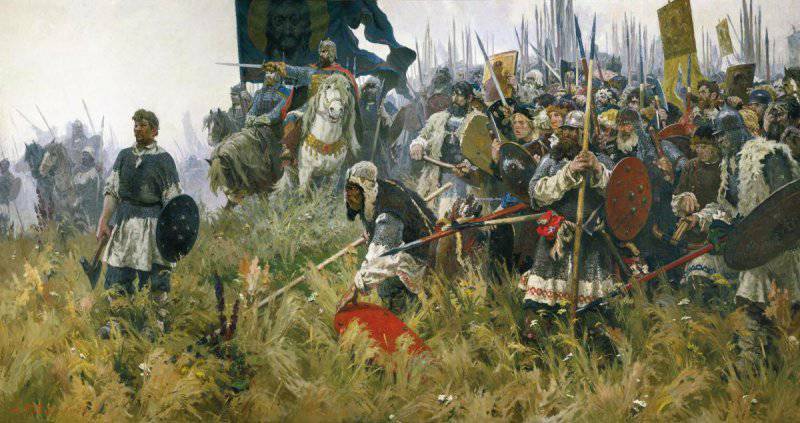
Information